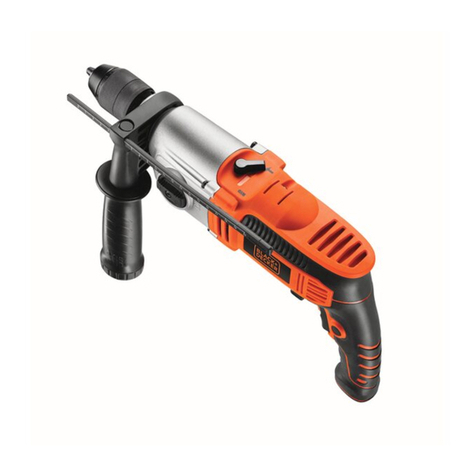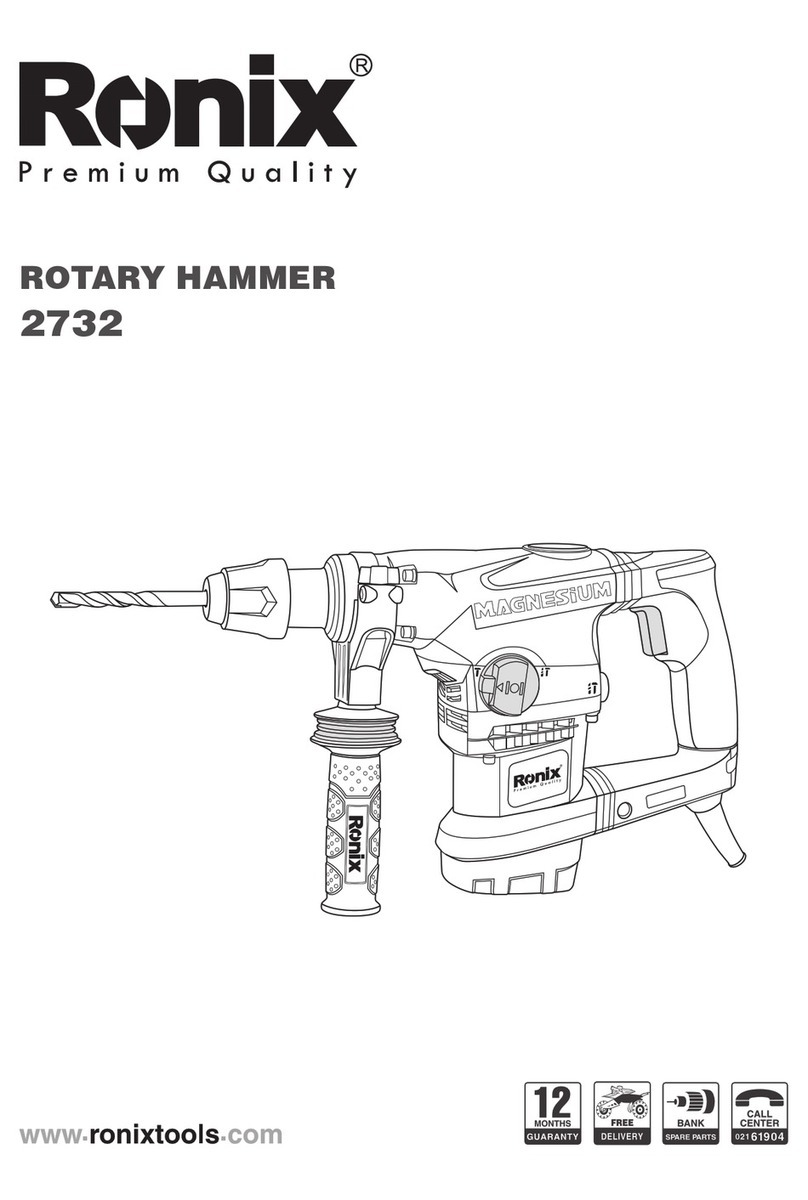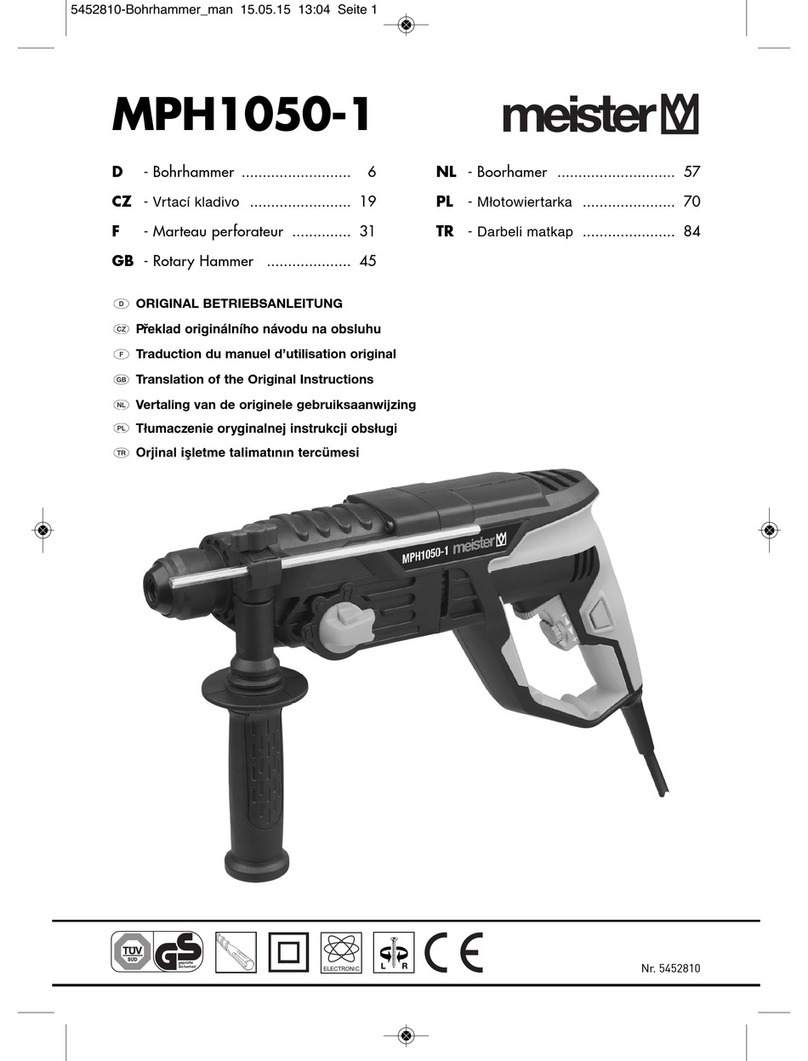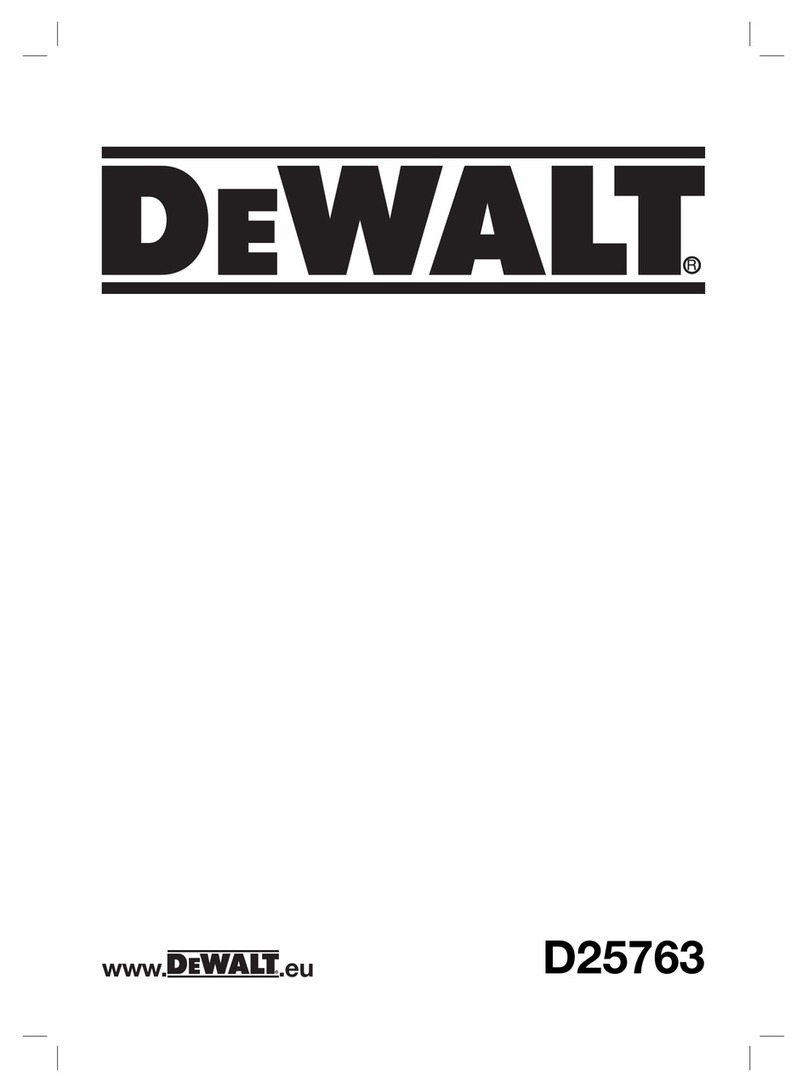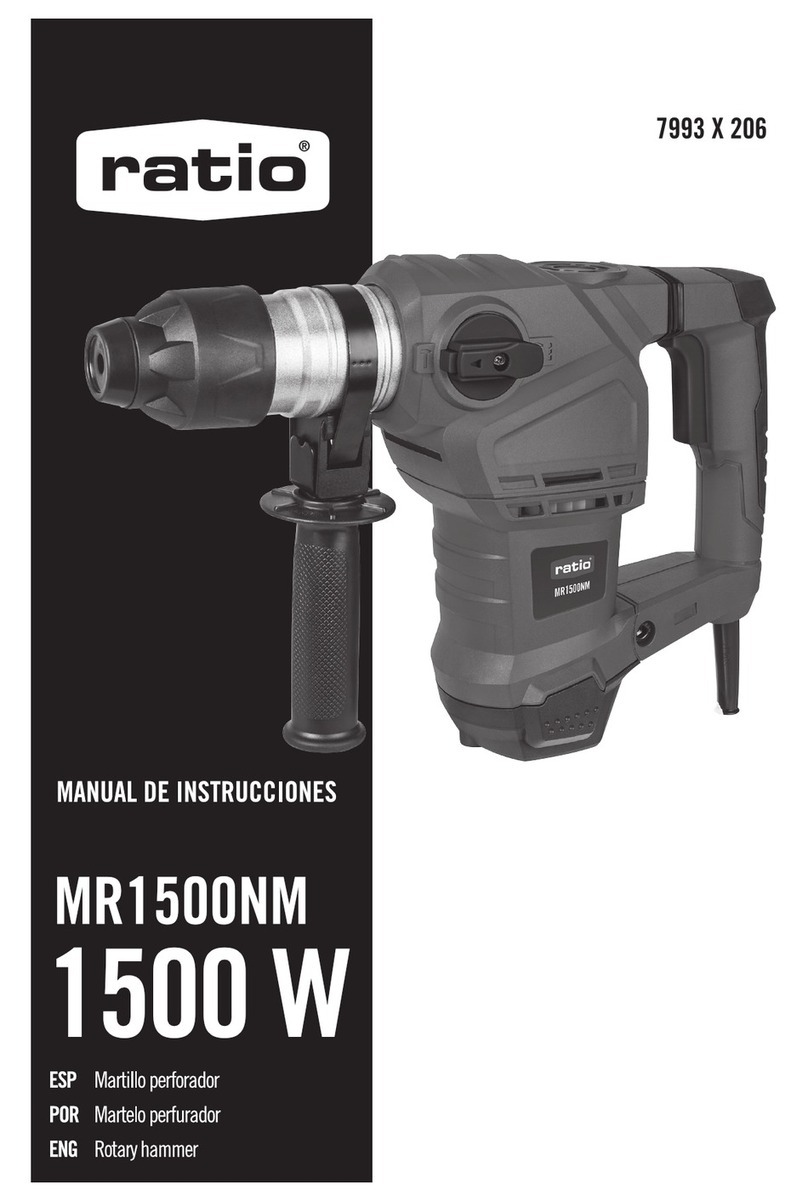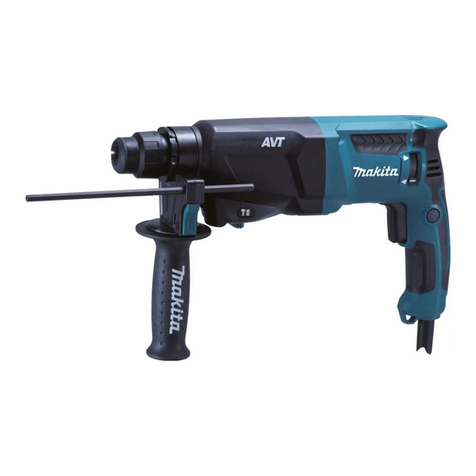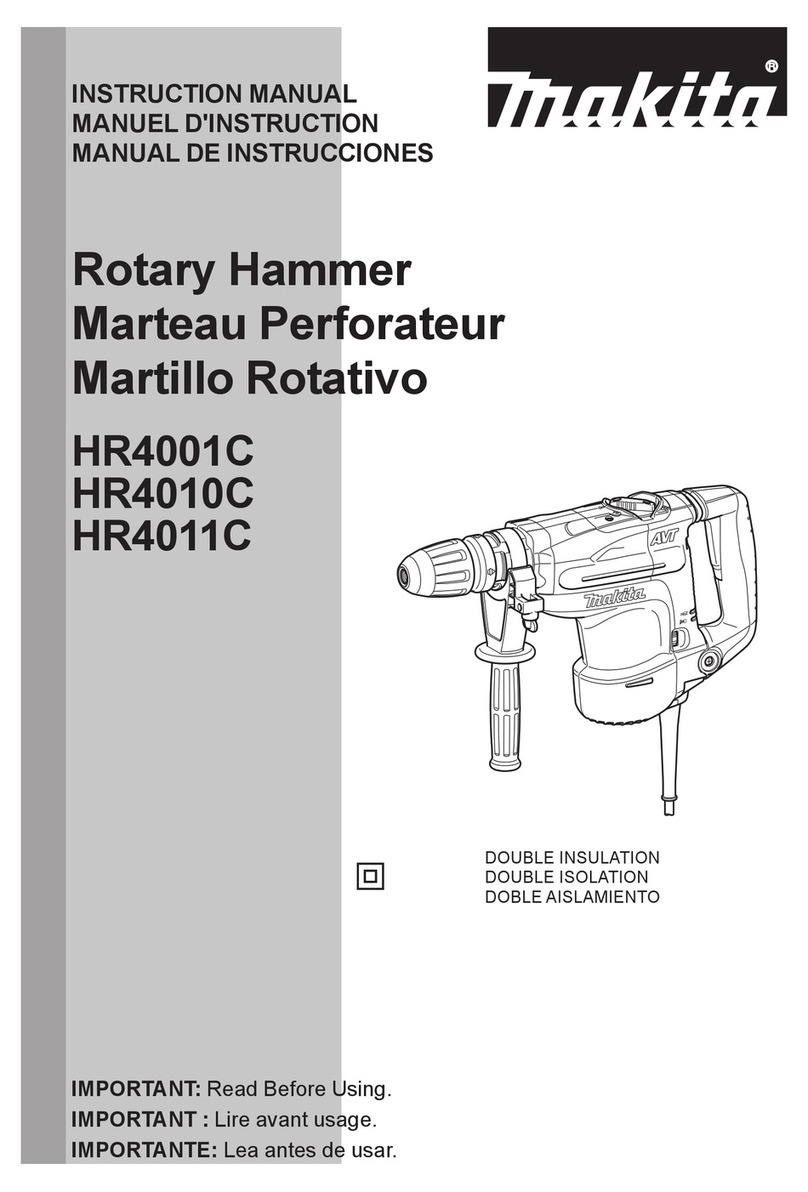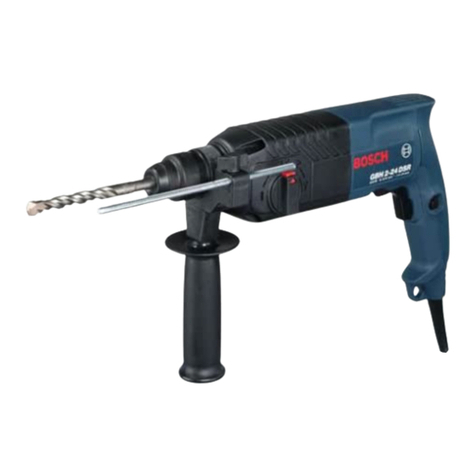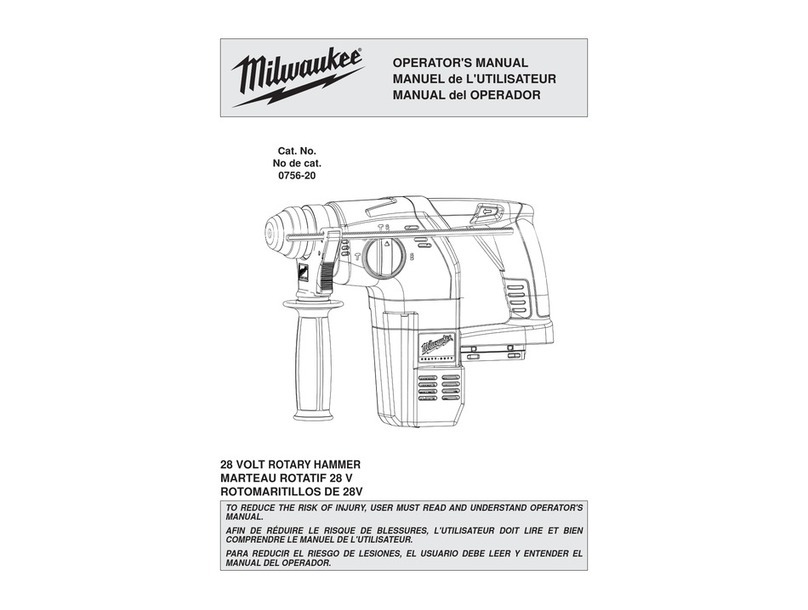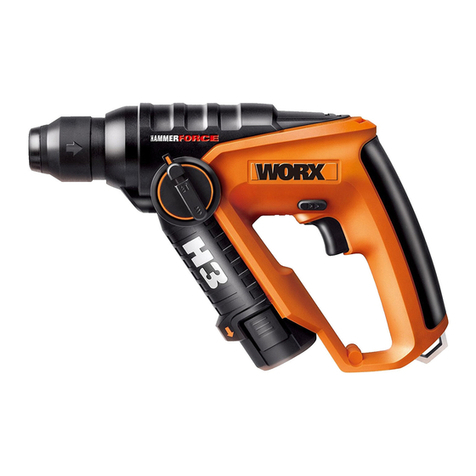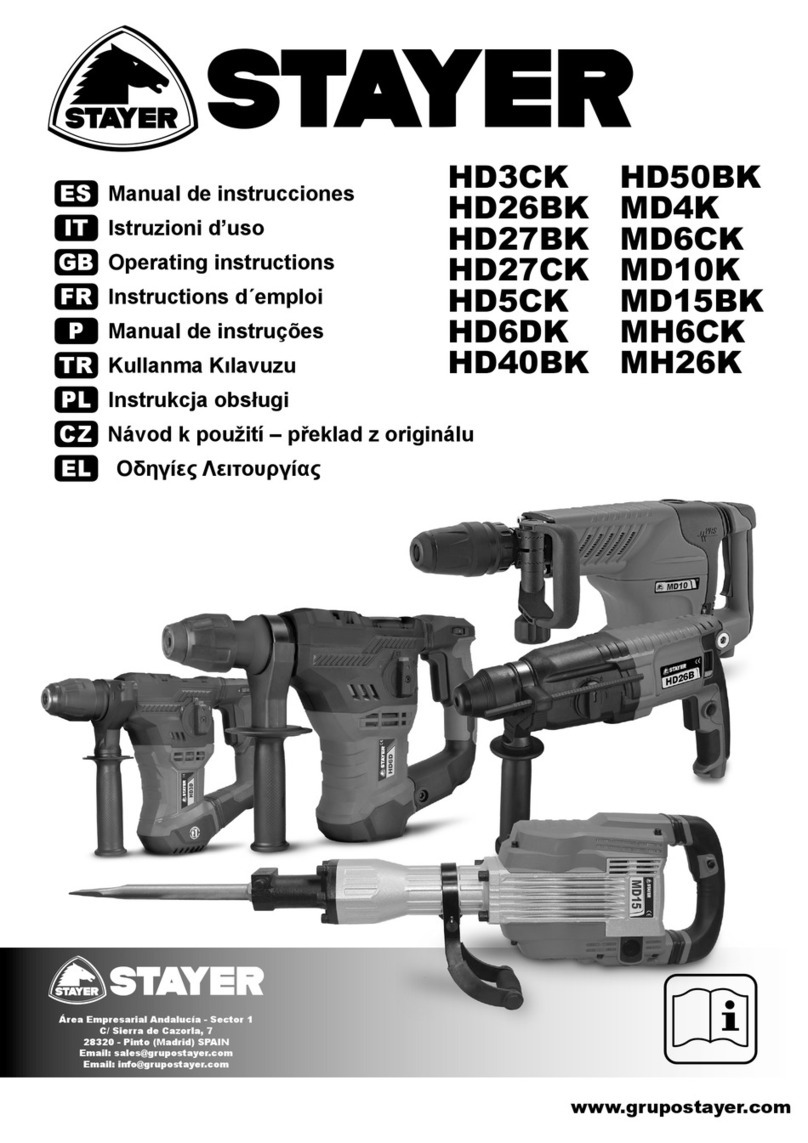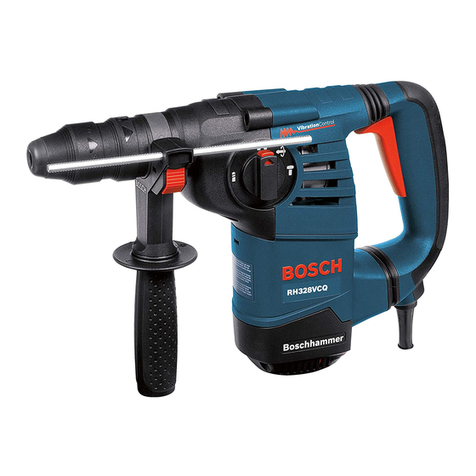Nemo RH-22-6Li-50 User manual


Functional Description and Specifications
Intended Use
The Nemo Rotary Hammer can be used underwater, in wet
conditions, and on dry land. This tool is a valuable asset to any
professional who works in and around water.
Packing List
Your Nemo Rotary Hammer is packaged together with the following
accessories:
♦Two rechargeable Lithium-ion (Li-ion) battery packs
♦Hand pump
♦Battery charger
♦Carrying case
♦Two drill bits - 6mm and 10mm
1

Technical Specifications
Nemo Submersible Rotary Hammer
Model
RH-22-6Li-50
Battery pack voltage
22V Li-ion
Battery cell specification
3Ah / 6Ah
No load speed (two speeds)
0 – 1040 RPM
Single impact energy
2.0 J
Full hammering frequency
0 – 4200 IPM
Net weight (with battery)
9.9lbs ( 4.5kg )
Maximum in steel diameter
1/8 – 1/2 in (3 – 13mm )
Maximum in wood diameter
1/8 – 1 in ( 3 – 26mm )
Maximum in concrete diameter
1/8 – 7/8 in ( 3 – 20mm )
Working temperature
32-140°F ( 0-60°C )
Submersible up to
164 ft ( 50m )
Battery Charger
Model
XVE-2520300
Approximate charging time
50 minutes
Charging output voltage
25.2V
Charging input voltage
100V – 240V
Caution: You must pressurize the Rotary Hammer before
you can use it underwater, as described in Pressurizing the
Rotary Hammer for Underwater Use, pages 9-11.
2

Safety Warnings
Warning: Read all safety warnings and instructions, and
save them for future reference. Failure to adhere to
these warnings can result in serious injury and damage
to equipment.
Work Area Safety
♦All work should be done in accordance with the local, state,
and government occupational safety and health guidelines.
♦Keep your work area clean and well lit.
♦Do not operate power tools in explosive atmospheres, such as
in the presence of flammable liquids, gases, or dust.
♦Keep bystanders away when operating power tools.
♦When using the tool on raised or high surfaces, make sure that
no one is underneath you when operating the tool.
Personal Safety
♦Stay alert and use common sense when operating power tools.
Do not use power tools when you are tired or under the
influence of drugs, alcohol, or medication.
♦Use personal protective equipment. It is recommended to
always wear eye protection, as well as a P2 filter-class
respirator.
♦Dust from materials such as lead-containing coating, some
wood types, minerals, and metal can be harmful to one’s
health. Observe the relevant regulations in your country for the
materials to be worked.
Power Tool Safety
♦Store idle power tools out of reach of children and do not allow
persons unfamiliar with the power tool or these instructions to
operate the power tool.
♦Maintain your power tools. Check for misalignment or binding
of moving parts, breakage of parts, and any other condition
3

that may affect the power tool’s operation. If damaged, have
the power tool repaired by an authorized service technician.
Caution: Under no circumstances should the power tool
be opened for repairs or any other purpose by anyone
other than an after-sales service technician authorized
by Nemo Power Tools. Opening the power tool
invalidates the manufacturer warranty.
♦Use power tools, accessories, and tool bits in accordance with
these instructions and in the manner intended for the
particular type of power tool, taking into account the working
conditions and the work to be performed. Consult local, state,
and government occupational safety and health guidelines
before operating a power tool.
♦Switch off the power immediately if the tool bit jams. Be
prepared for high reaction torque that can cause kickback. The
tool bit can jam when the power tool is subject to overload, or
if it becomes wedged in the workpiece.
♦Hold the power tool with a firm grip. High reaction torque can
briefly occur while driving in and loosening screws.
♦Work only on secured, stable items. Do not hold any item to be
worked on by the power tool in your hand. Secure the
workpiece, clamped with clamping devices or in a vice, to
ensure safety.
♦Always wait until the power tool has come to a complete stop
before placing it down. The tool bit can jam and lead to loss of
control over the power tool.
♦If using the rotary hammer above water or in hot conditions,
cool the tool down by dipping it in cool water regularly to
prevent overheating.
4

Rechargeable Battery Safety
♦Use only the battery pack supplied with your power tool.
♦When the battery pack is not in use, keep it away from other
metal objects like paper clips, coins, keys, nails, and screws,
which can make a connection from one terminal to another.
♦Store the battery pack only within a temperature range of 32˚F
- 113˚F ( 0˚C - 45˚C ) .
♦Before any work on the power tool, such as a tool change, as
well as during transportation and storage, remove the battery
pack from the power tool. There is danger of injury when
accidently activating the On/Off trigger.
♦Do not open the battery.
♦Protect the battery against heat, including continuous sun
irradiation and fire.
♦When the battery is defective, liquid can escape and come into
contact with adjacent components.
♦Use only original batteries with the voltage listed on the
nameplate of your power tool. When using other batteries,
such as imitations, reconditioned batteries, or other brands,
there is danger of injury as well as property damage through
exploding batteries.
♦Use only the battery charger provided with the power tool to
recharge the batteries. Only this battery charger is matched to
the lithium-ion (Li-ion) battery of your power tool.
♦Protect the battery charger from rain and moisture. The battery
charger is not waterproof.
♦Do not charge other batteries. The battery charger is suitable
only for charging the battery pack supplied with the tool.
♦Before use, always check the battery charger, cable, and plug. If
defects are detected, do not use the battery charger. Never
open the battery charger. Instead, have it opened and repaired
only by qualified personnel who will use original spare parts.
5

Getting Started with the Rotary Hammer
Your Nemo Rotary Hammer (RH-22-6Li-50) includes the following
main components:
Charging the Battery
The Li-ion batteries are supplied partially charged, and must be
charged to full capacity using the battery charger provided with the
rotary hammer before using the rotary hammer for the first time.
Caution: Only use the battery charger provided with
the rotary hammer. Only this battery charger is
matched to the Li-ion batteries supplied with your
power tool.
Danger: Ensure that the voltage of the power supply
corresponds with the data given on the nameplate of
the battery charger.
Danger: Only use the charger in a dry environment. The
charger is not waterproof. Never attempt to charge the
battery under water.
6

Stock: Make sure there is no metal or other things to
block the connector after every dive and keep the brass
pin dry when storing.
A battery can be charged at any time without reducing its service
life. This is because the battery charger detects the charging
condition of the battery, and charges it with the optimum current
according to its temperature and voltage. This lengthens the
battery life and leaves it fully charged when stored in the charger.
Interrupting the charging procedure does not damage the battery.
1. Connect the mains plug of the battery charger to an electrical
outlet. A steady green light on the battery charger indicates
that the charger is ready for operation.
2. Press the battery charger’s connector into the socket on the
top of the battery pack. There is only one way to insert the
connector into the battery socket.
The battery begins charging as soon as it is connected to the
charger.
⬥A steady red light on the battery charger indicates that
the battery is charging.
⬥A steady green light on the battery charger indicates that
the battery is fully charged.
Note: The battery is equipped with an NTC temperature
controller that only allows it to be charged when its
7

temperature is between 32˚ F - 113˚ F ( 0˚C- 45˚C ) ,
ensuring a long battery service life.
3. When you are ready to use the battery, pull it vertically out of
the charger.
Inserting a Battery into the Rotary Hammer
Before inserting the battery, always check to see that the switch
trigger actuates properly and returns to the "OFF" position when
released.
Caution: To minimize the risk of accidental activation,
always ensure the tool is switched off before
performing any maintenance work on the rotary
hammer, as well as during transportation and storage.
1. Ensure the 3-prong connector is in alignment with the 3 holes on
top of the battery .
2. Insert the battery into the bottom of the rotary hammer base.
3. Close the two plastic clips on the side to secure the rotary
hammer into position .
Caution: Use only a Li-ion battery from the original
factory with the voltage listed on the nameplate of your
rotary hammer. Using other batteries not suitable for
the rotary hammer can lead to malfunctions, cause
damage to the power tool, and pose a fire hazard.
Removing a Battery from the Rotary Hammer
1. Unfasten the two plastic clips on the side.
2. Pull the battery pack down.
Fitting the Rotary Hammer Handle
The handle enables you to hold the rotary hammer securely.
1. Ensure the On/Off trigger is in the Off position.
8

Caution: To minimize the risk of accidental activation,
always ensure the tool is switched off before
performing any maintenance work on the rotary
hammer, as well as during transportation and storage.
2. To attach front auxiliary safety handle, twist the bottom of the
handle to the left to loosen the metal ring
3. Slide the metal ring over the chuck. Tighten the bottom of the
handle to the right, to secure the front safety handle in place.
Pressurizing the Rotary Hammer for Underwater Use
Your rotary hammer can be used in any wet conditions, and can be
submerged and used underwater at depths of up to 164ft ( 50m ).
Before submerging the rotary hammer to any depth, it must be
pressurized.
1. Remove the red cap from the pressure valve on the base of the
rotary hammer.
2. Attach a pump, such as the hand pump supplied with the
rotary hammer, to the valve.
9

3. Pressurize the rotary hammer according to the depth to which
you are going to submerge it, as follows:
Depth in meters
Depth in feet
Pressure
Up to 5m
16 feet
Minimum
15 psi
( 1 Bar )
Up to 10m
33 feet
Minimum
29 psi
( 2 Bars )
Up to 20m
66 feet
Minimum
44 psi
( 3 Bars )
Up to 30m
98 feet
Minimum
58 psi
( 4 Bars )
Up to 40m
131 feet
Minimum
73 psi
( 5 Bars )
Up to 50m
164 feet
Maximum
87psi (6 Bar)
10

Caution: Never add more than 87 psi ( 6 Bars ) of
pressure to the rotary hammer.
Pressurizing the Battery for underwater use
You must pressurize the battery before using the
Angle Grinder underwater . To pressurize , remove the
red cap covering the Schrader valve and attach a
suitable pump to the Schrader valve . Pressurize the
battery to at least 3 bars . Pressurizing over 3 bars may
activate the over-pressure relief valve and release too
much air from the battery. ( If the over-pressure relief
valve releases air before reaching 3 bars , contact Nemo
Power Tools for a replacement relief valve .) After
pressurizing the battery, replace the red cap on the
Schrader valve.
Best Practices for Underwater Operation
Your Nemo Submersible Rotary Hammer is designed to be
waterproof, so that it can be used both on land and underwater. To
obtain the maximum serviceable life of your rotary hammer, adhere
to the following best practices when using the rotary hammer
underwater:
♦You must pressurize the rotary hammer before using it
underwater, as described in Pressurizing the Rotary Hammer
for Underwater Use, pages 9-11.
♦Do not exceed the maximum operational depth as
recommended by the manufacturer.
♦The rotary hammer is a hi-tech piece of equipment and should
be treated with care. Its watertight seals may be damaged if it
is dropped.
11

♦The rotary hammer can be used in salt water.
Note: After using therotary hammer in salt water,
immediately rinse it in fresh water to remove all salt
residue.
♦Before storing the rotary hammer in the carrying case after use
in water , rinse it with fresh water and dry it off .
♦Treat the high quality battery with care .Keep the battery fully
charged and dry and ready for use , and always store it in the
carrying case when not in use .
♦Post dive maintenance. : Water trapped inside the female battery
connection may corrode the terminals . Use compressed air to
flush out any remaining water trapped in the 3 large holes on the
battery connection.
Operating the Rotary Hammer
Switching the Rotary Hammer On or Off
♦Press the On/Off trigger, and keep it pressed. You can increase
the speed of the rotary hammer by increasing the pressure on
the switch. To switch off the rotary hammer, release the On/Off
trigger.
Inserting Tools
The rotary hammer utilizes an SDS-plus attachment system for easy,
secure tool insertion.
1. Clean tools and apply a thin layer of machine grease
before fitting.
2. Pull back the fastening sleeve and hold it in place.
3. Push the tool into the holder and rotate it until it locks.
12

4. Test the tool by pulling it straight out to make sure it
remains securely in place.
Removing Tools
Pull the fastening sleeve back, hold it in place, and remove the tool.
13

Choosing Your Function
Use the dial on the rotary hammer to choose your function. The
rotary hammer comes with three separate functions: rotation and
hammering; rotation-only; hammering-only. To switch to your
chosen mode, hold down the push button and move the lever to
the desired mode.
Choose the rotation and hammering function to rotary hammer:
14

⬥anchor holes
⬥holes in concrete
⬥holes in tile
Choose the rotation-only function to:
⬥drill holes in steel or wood
⬥tighten machine screws and wood screws
Choose the hammering-only function for:
⬥Light concrete chiseling
⬥groove digging
⬥edging
Tips for Use
♦Always put the bit in contact with the surface you’re working
on prior to pulling the trigger for maximum control.
♦Always hold the rotary hammer firmly and use moderate, even
pressure. Applying too much pressure, especially at lower
speeds, will cause the hammer to stall. Utilizing too little
pressure or uneven pressure can cause the bit to skip and slide
over the surface and/or prevent it from cutting through the
work surface.
♦Wipe the shanks of the bits clean prior to installation and
immediately after removing them from the rotary hammer.
Maintenance
Rotary Hammer Care
♦When working in cold weather or when operating the tool after
it has been stored for a long time, run the tool under no load
for several minutes. This lubricates the tool and warms it up. If
it is not properly warmed and lubricated, the rotary hammer
will be difficult to operate.
15

♦Blow air through the tool housing after every use to remove
dust.
♦Rinse the rotary hammer with fresh water after exposure to
salt water. The rotary hammer can be used in salt water, but
allowing salt to build-up on the tool shortens its lifespan.
♦Do not use solvents or cleaning supplies to clean the rotary
hammer. Fresh water and soft, lint-free cloths are all that are
necessary.
♦Post dive maintenance. :Water trapped inside the female
battery connection may corrode the terminals . Use
compressed air to flush out any remaining water trapped in the
3 large holes on the battery connection.
Servicing the Rotary Hammer
If your rotary hammer is damaged or faulty, have it repaired by an
authorized service technician.
Caution: Under no circumstances should the rotary
hammer be opened for repairs or any other purpose by
anyone other than an after-sales service technician
authorized by Nemo Power Tools. Opening the rotary
hammer invalidates the manufacturer warranty.
16

Transporting the Rotary Hammer
For maximum protection, always transport your rotary hammer
secured in its carrying case, with the battery removed.
The battery pack has effective protection against internal
over-pressure and short-circuiting, as well as devices preventing
violent rupture and dangerous reverse current flow.
The lithium-equivalent content in the batteries is below applicable
limit values. Therefore, the batteries are not subject to national or
international regulations pertaining to dangerous mediums, either
as individual components or when inserted into a power tool.
However, the regulations governing dangerous goods may be
relevant when transporting several batteries. In this case, it might
be necessary to comply with special conditions, such as those
governing packaging.
Disposing of the Rotary Hammer
At the end of its lifecycle, the rotary hammer, its accessories, and
packaging should be sorted for environmentally friendly recycling.
Do not dispose of the battery pack in household waste, fire, or
water. Battery packs should be collected, recycled, or disposed of in
an environmentally friendly manner.
17

Troubleshooting Battery and Charger
Problem: The battery is not charging, and there is a blinking red
light on the battery charger.
Possible Cause
Corrective Action
The battery is not
correctly inserted into the
charger.
Remove the battery from the
charger, then re-insert it correctly.
The battery contacts are
contaminated.
Clean the battery contacts, for
example by removing and inserting
the battery several times, or replace
the battery.
The battery is defective.
Replace the battery.
Problem: The battery charger indicator does not light up.
Possible Cause
Corrective Action
The mains plug of the
battery charger is not
correctly plugged into the
socket.
Insert the mains plug fully into the
socket outlet, and ensure that the
socket is functional.
The socket outlet, mains
cable, or battery charger
are defective.
Check the voltage power; have the
battery charger checked by an
authorized after-service agent.
18

Caution: Under no circumstances should the rotary
hammer or accessories be opened for repairs or any
other purpose by anyone other than an after-sales
service technician authorized by Nemo Power Tools.
Opening the rotary hammer invalidates the
manufacturer warranty.
Problem: The battery charger is warm to the touch.
Possible Cause
Corrective Action
Continuous or repetitive
charging cycles without a
break may cause the
charger to warm up.
No corrective action is required as
this does not indicate a fault with the
battery charger.
Problem: The battery operation time is significantly reduced,
even after the battery is fully charged.
Possible Cause
Corrective Action
The battery is defective,
or has reached the end of
its life (approximately
1000 charging cycles).
Replace the battery.
19
Table of contents

